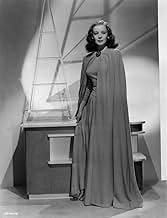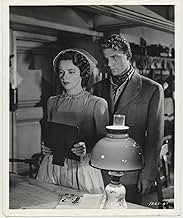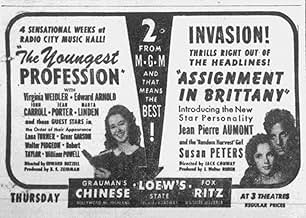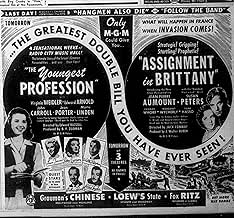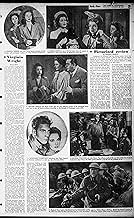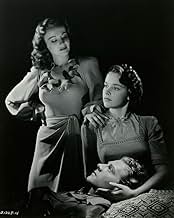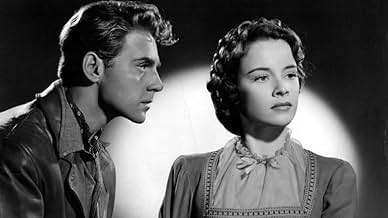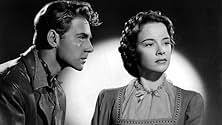Füge eine Handlung in deiner Sprache hinzuA French captain (Jean-Pierre Aumont) poses as a Nazi to pinpoint a U-boat base off the coast of France, while assuming the identity of a look-a-like French citizen.A French captain (Jean-Pierre Aumont) poses as a Nazi to pinpoint a U-boat base off the coast of France, while assuming the identity of a look-a-like French citizen.A French captain (Jean-Pierre Aumont) poses as a Nazi to pinpoint a U-boat base off the coast of France, while assuming the identity of a look-a-like French citizen.
Jean-Pierre Aumont
- Bertrand Corlay
- (as Pierre Aumont)
- …
Handlung
WUSSTEST DU SCHON:
- WissenswertesThe Germans built several submarine bases on the west coast of France after their occupation of the country in 1940. Enormous submarine pens of reinforced concrete were erected at Bordeaux, Brest, La Pallice, Lorient and Saint-Nazaire. These structures protected the U-Boats from attack and allowed them freer access to the Atlantic Ocean, as the submarines did not have to transverse the English Channel or go around the UK via the North Sea from bases in Germany. As of 2020 these massive constructions are still largely intact and some have even been re-purposed. The pens at La Pallice can be seen in Das Boot (1981) and Jäger des verlorenen Schatzes (1981).
- PatzerAs Corlay and Kerenor are about to enter the pub, a German guard stops them. Kerenor says, "One uncovers. It's good form for the content." They take their hats off and enter. But once inside, only they have their hats off. All the other Frenchmen of the town, and the German officers, have their hats on their heads.
- Zitate
Jean Kerenor: [as he and Metard/Corlay are stopped by a guard from entering a pub] One uncovers. It's good form for the content.
[German officers as well as town folk are seated inside]
Ausgewählte Rezension
First, let's start with the very clear purpose of this movie - because, during World War II, when Hollywood made a movie about the war, it had clear reasons for doing so.
When the Germans invaded France (and Belgium and Holland) in May, 1940, it quickly became apparent that the (then) Allies were unprepared for Blitzkrieg, (Why and who was to blame is a story for another day.) By June France was overrun and the French army, what was left of it, was quite simply fleeing before the German invaders. The French government, as unprepared as the French army, turned over power to the very conservative Philippe Pétain, a World War I hero, and he negotiated an armistice with the Germans. The French therefore stopped fighting - except for those who fled to England to continue the fight under Ch De Gaulle. Here in the States, that was depicted in large headlines as "The French Quit."
FDR realized that France could not be written off as a nation of collaborators, because if we were ever to defeat the Germans, we would have to land there. And so, Hollywood was directed to find ways of showing that not all the French were Nazi sympathizers. (On this, see the very useful book Hollywood Goes to War: How Politics, Profit and Propaganda Shaped World War II Movies.) This led to movies like *Reunion in France* (1942), *Paris After Dark* (1943), and this movie. Its first purpose was to show that, while there were indeed collaborators among the French, there were also brave anti-Nazis - there is no indication of a real organized Resistance in this movie.
The second purpose of this movie was evidently to appeal to women with a love story and a very handsome leading man, the French actor Jean-Pierre Aumont, in what was evidently his first American movie. (His English is very good.) I found this love story, with Susan Peters, to be of no interest at all. There's no chemistry between them at all. That's probably why the movie is now forgotten. Aumont was better looking than Bogart, but Peters couldn't hold a candle to Bergman - no woman could - and their scenes together are of no interest.
What I found interesting about this movie, which was probably filmed very quickly - the novel on which it was based came out just the year before, in 1942 - is that, despite the title, it presents a very generic, and indeed non-Breton Brittany. It takes place near St. Lunaire, in the Côtes d'Armor, where I have lived for 20 years, and I can assure you that none of the architecture, and almost none of the costumes, look like what one sees, or would have seen, there. Even the names are not Breton. (I don't know if they are the same as in Helen MacInnes' novel.) Why MGM didn't bother to go for something more authentic I can't guess, since they certainly had the resources to do so. Perhaps it was because they figured that Americans in 1943 and before, even those who had traveled to France, were unlikely to have known Brittany. (That seems to be symbolized by the final image, Mont St. Michel, which American tourists would have visited, but which is in Normandy.) Perhaps it was just because they were in a rush and didn't want to bother.
No one, but no one, who knew Brittany at the time would have believed for one moment that a Frenchman from another part of France - Métard/Aumont is presented as being from NE France - could have passed for a small-town Breton for even 30 seconds once he opened his mouth and started speaking French with a non-Breton accent. Whether that is dealt with in MacInnes' novel I don't know.
So, is there anything to recommend here, since the love story and even the basic premise of Métard passing for a small-town Breton are unconvincing? I found the staging of the attack on the submarine base to be well done. Yes, the torpedo boats are clearly toys floating in something like a bathtub. But other than that, I thought that part of the movie was well done. (The director, Jack Conway, had done some great action movies, like *Vivo Villa* and *A Tale of Two Cities*.)
When you watch this movie - and I hope you will, if you're interested in World War II - I hope you'll try to watch it as Americans would have seen it in 1943, a time when we had just entered the war and no one knew if the Germans would retain control of Europe. That gives it a power that an ahistorical viewing does not have.
When the Germans invaded France (and Belgium and Holland) in May, 1940, it quickly became apparent that the (then) Allies were unprepared for Blitzkrieg, (Why and who was to blame is a story for another day.) By June France was overrun and the French army, what was left of it, was quite simply fleeing before the German invaders. The French government, as unprepared as the French army, turned over power to the very conservative Philippe Pétain, a World War I hero, and he negotiated an armistice with the Germans. The French therefore stopped fighting - except for those who fled to England to continue the fight under Ch De Gaulle. Here in the States, that was depicted in large headlines as "The French Quit."
FDR realized that France could not be written off as a nation of collaborators, because if we were ever to defeat the Germans, we would have to land there. And so, Hollywood was directed to find ways of showing that not all the French were Nazi sympathizers. (On this, see the very useful book Hollywood Goes to War: How Politics, Profit and Propaganda Shaped World War II Movies.) This led to movies like *Reunion in France* (1942), *Paris After Dark* (1943), and this movie. Its first purpose was to show that, while there were indeed collaborators among the French, there were also brave anti-Nazis - there is no indication of a real organized Resistance in this movie.
The second purpose of this movie was evidently to appeal to women with a love story and a very handsome leading man, the French actor Jean-Pierre Aumont, in what was evidently his first American movie. (His English is very good.) I found this love story, with Susan Peters, to be of no interest at all. There's no chemistry between them at all. That's probably why the movie is now forgotten. Aumont was better looking than Bogart, but Peters couldn't hold a candle to Bergman - no woman could - and their scenes together are of no interest.
What I found interesting about this movie, which was probably filmed very quickly - the novel on which it was based came out just the year before, in 1942 - is that, despite the title, it presents a very generic, and indeed non-Breton Brittany. It takes place near St. Lunaire, in the Côtes d'Armor, where I have lived for 20 years, and I can assure you that none of the architecture, and almost none of the costumes, look like what one sees, or would have seen, there. Even the names are not Breton. (I don't know if they are the same as in Helen MacInnes' novel.) Why MGM didn't bother to go for something more authentic I can't guess, since they certainly had the resources to do so. Perhaps it was because they figured that Americans in 1943 and before, even those who had traveled to France, were unlikely to have known Brittany. (That seems to be symbolized by the final image, Mont St. Michel, which American tourists would have visited, but which is in Normandy.) Perhaps it was just because they were in a rush and didn't want to bother.
No one, but no one, who knew Brittany at the time would have believed for one moment that a Frenchman from another part of France - Métard/Aumont is presented as being from NE France - could have passed for a small-town Breton for even 30 seconds once he opened his mouth and started speaking French with a non-Breton accent. Whether that is dealt with in MacInnes' novel I don't know.
So, is there anything to recommend here, since the love story and even the basic premise of Métard passing for a small-town Breton are unconvincing? I found the staging of the attack on the submarine base to be well done. Yes, the torpedo boats are clearly toys floating in something like a bathtub. But other than that, I thought that part of the movie was well done. (The director, Jack Conway, had done some great action movies, like *Vivo Villa* and *A Tale of Two Cities*.)
When you watch this movie - and I hope you will, if you're interested in World War II - I hope you'll try to watch it as Americans would have seen it in 1943, a time when we had just entered the war and no one knew if the Germans would retain control of Europe. That gives it a power that an ahistorical viewing does not have.
- richard-1787
- 23. Mai 2020
- Permalink
Top-Auswahl
Melde dich zum Bewerten an und greife auf die Watchlist für personalisierte Empfehlungen zu.
Details
- Erscheinungsdatum
- Herkunftsland
- Sprache
- Auch bekannt als
- Uppdrag i Bretagne
- Drehorte
- Produktionsfirma
- Weitere beteiligte Unternehmen bei IMDbPro anzeigen
- Laufzeit1 Stunde 36 Minuten
- Farbe
- Seitenverhältnis
- 1.37 : 1
Zu dieser Seite beitragen
Bearbeitung vorschlagen oder fehlenden Inhalt hinzufügen


